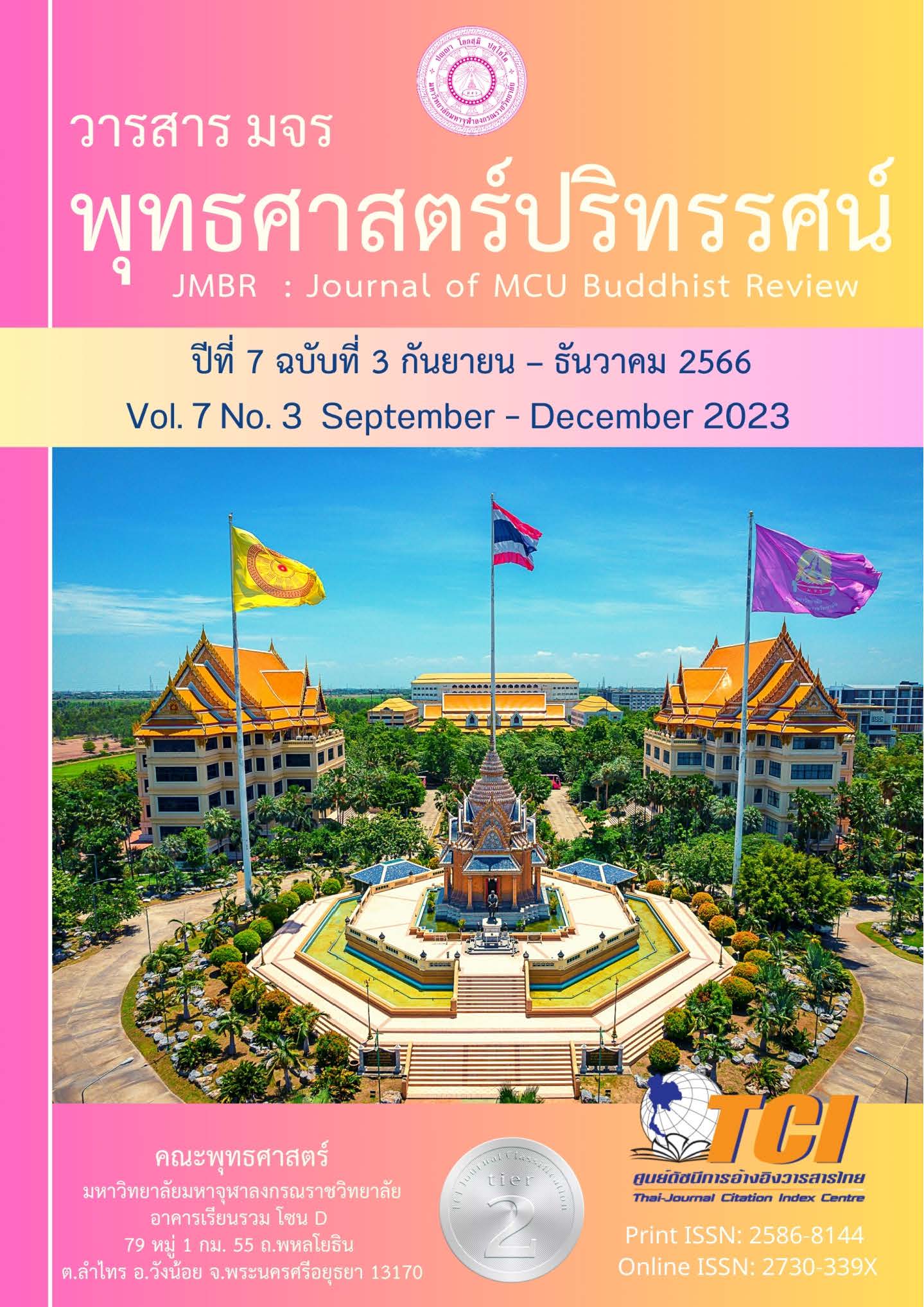สร้างโมเดลป้องกันและลดการป่วยซ้ำซ้อนพระสงฆ์ป่วยโรคเบาหวาน โรคความดันโลหิตสูงแบบพึ่งพาตนเอง รองรับการลดภาระงบประมาณภาครัฐ
Main Article Content
บทคัดย่อ
บทความวิจัยนี้มีวัตถุประสงค์ 1) การสร้างต้นแบบป้องกันและลดอาการป่วยซ้ำซ้อนพระสงฆ์ป่วยโรคเบาหวาน โรคความดันโลหิตสูง 2) สร้างเครือข่ายป้องกันและลดการป่วยซ้ำซ้อนพระสงฆ์ป่วยโรคเบาหวานโรคความดันโลหิตสูงแบบพึ่งพาตนเอง รองรับการลดภาระงบประมาณภาครัฐ วิธีดำเนินการวิจัยเชิงคุณภาพ ผู้ให้ข้อมูลสำคัญ จำนวน 30 รูปหรือคน โดยใช้วิธีการเลือกสุ่มตัวอย่างแบบเจาะจง เครื่องมือที่ใช้ในการวิจัย ได้แก่ แบบสัมภาษณ์ ใช้วิธีการวิเคราะห์ข้อมูลแบบพรรณนาความ
ผลการวิจัยพบว่า 1) การสร้างต้นแบบป้องกันและลดอาการป่วยซ้ำซ้อนพระสงฆ์ป่วยโรคเบาหวาน โรคความดันโลหิตสูง ได้แก่ (1) การดูแลตัวเอง ด้วยการเรียนรู้สร้างความเข้าใจเพื่อปรับพฤติกรรม การฉันอาหาร ฉันยา ออกกำลังกาย และควบคุมอารมณ์ (2) การจัดทำฐานข้อมูล ดำเนินการรวบรวมข้อมูล พระสงฆ์ที่ป่วยในพื้นที่เพื่อนำข้อมูลมาใช้เพื่อรักษาสิทธิ์ของผู้ป่วย ภายใต้การสนับสนุนงบประมาณจากภาครัฐ (3) ปฏิทินสุขภาพ วางแผนกิจกรรมในแต่ละวัน การฉันอาหาร ออกกำลังกาย ลงมือปฏิบัติให้เกิดความต่อเนื่อง (4) ความร่วมมือ ร่วมริเริ่ม ร่วมคิด วางวิสัยทัศน์ กำหนดทิศทาง ร่วมปฏิบัติตามแนวทาง ร่วมประเมิน และร่วมแก้ไขปรับปรุง (5) เครือข่าย ประสานความร่วมมือระหว่างหน่วยงานภาครัฐ คณะสงฆ์ วัดในพื้นที่ เพื่อเชื่อมต่อความร่วมมือลดอาการป่วยของพระสงฆ์ 2) สร้างเครือข่ายป้องกันและลดการป่วยซ้ำซ้อนพระสงฆ์ป่วยโรคเบาหวานโรคความดันโลหิตสูงแบบพึ่งพาตนเอง รองรับการลดภาระงบประมาณภาครัฐ ได้แก่ เจ้าหน้าที่สาธารณสุข องค์การบริหารส่วนตำบล โรงพยาบาลส่งเสริมสุขภาพประจำตำบล คณะสงฆ์วัด อาสาสมัครสาธารณสุขประจำวัด มหาวิทยาลัยมหาจุฬาลงกรณราชวิทยาลัย ร่วมกันเป็นผู้ให้คำแนะนำให้ความรู้ ประชาสัมพันธ์ให้พระสงฆ์รับรู้เรื่องการส่งเสริมสุขภาพ สนับสนุนงบประมาณดูแลสุขภาพโครงการกองทุนหลักประกันสุขภาพ สนับสนุนการวิจัย ให้เกิดแนวคิดสนับสนุนพระสงฆ์ไทยหากไกลโรค ส่งผลให้เกิดความร่วมมือดูแลสุขภาพพระสงฆ์ในด้านต่างๆ มากขึ้น
การดูแลสุขภาพตนเองของพระสงฆ์ตามแนวปฏิบัติการดูแลสุขภาพของตนเอง การบริโภคอาหาร การจัดการความเครียด สามารถรักษาสุขภาพตนเองได้อย่างถูกต้องและเหมาะสม รวมทั้งการสร้างเครือข่ายเพื่อเชื่อมโยงแลกเปลี่ยนข่าวสารร่วมกัน ทำกิจกรรมร่วมกันระหว่างหน่วยงานภาครัฐ ภาคเอกชน วัด การมีส่วนร่วมของสมาชิกทุกคนในเครือข่าย ส่งผลให้พระสงฆ์ที่ป่วยสามารถพึ่งพาตนเองได้และสามารถรลดภาระงบประมาณภาครัฐได้อีกด้วย
Article Details

อนุญาตภายใต้เงื่อนไข Creative Commons Attribution-NonCommercial-NoDerivatives 4.0 International License.
- บทความที่ได้รับการตีพิมพ์เป็นลิขสิทธิ์ของวารสาร มจร พุทธศาสตร์ปริทรรศน์
- ข้อความใดๆ ที่ปรากฎในบทความที่ได้รับการตีพิมพ์ในวารสาร ถือเป็นความรับผิดชอบของผู้เขียนบทความ และข้อคิดเห็นนั้นไม่ถือว่าเป็นทัศนะและความรับผิดชอบของกองบรรณาธิการวารสาร มจร พุทธศาสตร์ปริทรรศน์
เอกสารอ้างอิง
กรมอนามัย กระทรวงสาธารณสุข. (2562). คู่มือการคัดกรองผู้ป่วยเบาหวาน ความดันโลหิตสูง, กรุงเทพฯ: โรงพิมพ์องค์กรทหารผ่านศึก.
จาริณี ยศปัญญา และวันเพ็ญ ศิวารมย์. (2550). การวิจัยการดูแลสุขภาพองค์รวมของพระภิกษุสามเณรในวัดส่งเสริมสุขภาพ. ขอนแกน: ศูนย์อนามัยที่ 6.
ทินพันธุ์ นาคะตะ. (2543). พระพุทธศาสนากับสังคมไทย. กรุงเทพฯ: สหายบล็อกและการพิมพ์.
ประภาเพ็ญ สุวรรณ. (2538). การส่งเสริมสุขภาพ: การปรับบทบาทใหม่ของสุขศึกษา เอกสารประกอบการประชุมวิชาการสุขศึกษาแห่งชาติ ณ โรงแรมเจริญโฮเต็ล ขอนแก่น.
ปราชญ์ บุญยวงศ์วิโรจน์ และคณะ. (2551). การขับเคลื่อนงานสาธารณสุขมูลฐาน ให้คนไทย มีสุขภาพดีถ้วนหน้าในปี พ.ศ. 2558. นนทบุรี: สำนักงานสารนิเทศและประชาสัมพันธ์ กระทรวงสาธารณสุข.
ปัณณธร ชัชวรัตน์. (2553). ปัจจัยที่มีผลต่อพฤติกรรมสุขภาพของพระสงฆ์ในเขตอำเภอเมือง จังหวัดพะเยา. รายงานการวิจัย พะเยา: วิทยาลัยพยาบาลบรมราชชนนีพะเยา.
ภัทรพล ตันเสถียร. (2550). คุณภาพชีวิตของพระสงฆ์ที่อาพาธด้วยโรคเรื้อรังที่มารับบริการทางการแพทย์ ณ โรงพยาบาลสงฆ์. วิทยานิพนธ์ศิลปศาสตรมหาบัณฑิต บัณฑิตวิทยาลัย: มหาวิทยาลัยมหิดล.
มหาจุฬาลงกรณราชวิทยาลัย. (2539). พระไตรปิฎกภาษาไทย ฉบับมหาจุฬาลงกรณราชวิทยาลัย. กรุงเทพฯ: โรงพิมพ์มหาจุฬาลงกรณราชวิทยาลัย.
วัลลา ตันตโยทัย และ อดิสัย สงดี. (2563). “การพยาบาลผู้ป่วยเบาหวาน” ใน การพยาบาลอายุรศาสตร์ เล่ม 4. รวบรวมโดย สมจิต หนุเจริญกุล. กรุงเทพฯ: วีเจ พริ้นติ้ง.
วิฑูร แสงสิงแกว. (2538). การประชุมวิชาการโรคไม่ติดต่อ. กรุงเทพฯ: กรมการแพทย์กระทรวงสาธารณสุข.
สมจิต หนุเจริญกุล. (2536). การดูแลตนเอง: ศาสตร์และศิลปะทางการพยาบาล. พิมพ์ครั้งที่ 2. กรุงเทพฯ: วีเจ พริ้นติ้ง.
สมพันธ์ เตชะอธิก และ วินัย วงศ์อาสา. (2555). “สุขภาวะชุมชนเพื่อความอยู่ดีมีสุข” วารสารมนุษยศาสตร์ สังคมศาสตร์. 29(2), 191-205.
สำนักงานหลักประกันสุขภาพแห่งชาติ. (2553). คูมือปฏิบัติงานกองทุนหลักประกันสุขภาพในระดับท้องถิ่นหรือพื้นที่. กรุงเทพฯ: สำนักงานหลักประกันสุขภาพแห่งชาติ.
สุรพันธ์ สุวรรณศรี, ทรงคุณ จันทจร และพระสุทธิสารโสภณ. (2552). การสร้างความสงบสุขในสังคม:การศึกษาแนวทางการบูรณาการกระบวนการเผยแผ่พระพุทธศาสนาและคริสต์ศาสนาในภาคอีสาน. วิทยานิพนธ์ปรัชญาดุษฎีบัณฑิต บัณฑิตวิทยาลัย: มหาวิทยาลัยมหาสารคาม
Jean, G. & David, E.G. (1970). Motivation and Modern Management. Massachusetts: Addison – Wesley Publishers.
Pender, N.J. (1996). Health Promotion in Nursing Practice. 2nd ed. Connecticut: Appleton and Lange.
Sanfords, F.H. & Sman, L.W. (1970). Psychology. 3rded. Beloment: Brooks Cols.
Steers, R.W. & Porter, L.W. (2015). Motivation and work behavior. 3rd ed. New York: Mc Graw –Hill.


